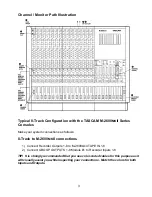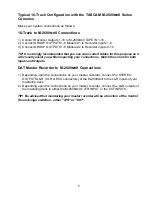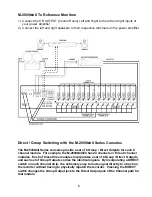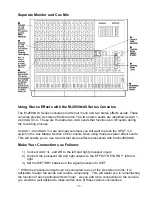
1
M-2600
MK
II
QUICK TIPS
M-2600
MK
II Application Guide Introductory Briefing
The M-2600
MK
II Series mixing console offers tremendous signal routing flexibility
combined with a versatile and musical equalization system. This guide is designed to
assist you in maximizing your use of the mixer. To gain the most from this guide, configure
your system as outlined on pages 3 and 4.
Taking Advantage of the M-2600
MK
II’s Split EQ Capability
The M-2600
MK
II Series Consoles provide four band, splittable EQ on each channel strip.
HI and LOW EQ are of the shelving variety while HI MID and LO MID EQ is sweepable.
Both types of equalization default to the Channel Path.
Beneath the HI and LOW EQ is a switch labeled MONitor. Pressing this switch places the
HI and LOW EQ in the monitor path. Beneath the HI MID and LO MID EQ there is another
switch labeled MONitor. Pressing this switch places the HI MID and LO MID EQ in the
monitor path.
Beneath the HI MID / LO MID EQ MON switch is another switch labeled EQ. This switch
inserts or removes the two types of equalization from the Channel Path only. Its function
is dependent upon the setting of the two MONitor switches.
By taking advantage of the MONitor switches found in the EQ section of the M-2600
MK
II
consoles, you have the advantage of using the EQ in any combination that best suits your
needs. As this level of flexibility provides countless opportunities to fine tune your mix, we
encourage you to experiment with this section of the console. The following example is
only one of many possible uses for splittable EQ.
You're mixing down eight tracks from tape with a number of virtual tracks via your MIDI
system. The tape recorder is feeding TAPE IN, channels 1 through 8, which are now
placed in the Channel Path via the FLIP switches. As your MIDI system is huge, you are
also using channel inputs 1 through 8 (LINE engaged) to accommodate the individual
outputs of your drum machine. These signals are now in the Monitor path. Channel
one of the console is managing both the brass parts on tape (Channel Path) and the
kick drum (Monitor Path) via the MIDI system.
You want to boost the low end punch of the kick drum. Press the upper MONitor switch in
the EQ section. You can now adjust the LOW EQ control and affect a change to the kick
drum.
By pressing the EQ button in the HI MID / LO MID area of the EQ section, you can now
experiment with the sweepable EQ to obtain the greatest clarity from your brass parts
which are in the Channel Path - ensuring this track has the bite that it needs to cut through
the mix.






























